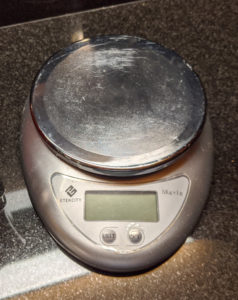
There are lots of tools and techniques you can use to get more consistent results from your baking or cooking. One of the easiest is to use a kitchen scale.
In the past, kitchen scales were rarely used by amateur cooks and hobbyists. The main reasons were convenience and cost. Older kitchen scales were bulky, took up a lot of shelf and counter space, and did not always provide accurate measurements. For those that looked good and worked well, the cost was prohibitive.
Well, times have changed. Today’s kitchen scales are compact, easy to use, highly accurate, and economical. As with most everything else these days, they have been transformed by the digital age, and they are easy to get. A search on Amazon for ‘kitchen scale’ yields dozens of results, with most available for less than $20.
Why you should use a kitchen scale
For the longest time, I avoided using a kitchen scale in my cooking and baking. I was happy to use measuring cups and spoons to mete out my ingredients. My recent foray into baking, particularly bread, made me rethink my ways.
I’ll dig deeper into this topic in another post, but there is a huge difference between baking and cooking. Baking is based on chemistry, and the ratios of ingredients are important, if not critical. For example, slight variations of the flour-water ratio in your bread dough can be the difference between perfection and disaster.
I was satisfied with my measuring cup technique, until I did some research on measuring flour. It turns out that depending on the method you use – scoop and level or spoon and level – the amount of flour can vary as much as 20% (see here for a more detailed analysis of different measuring techniques – https://www.loveandoliveoil.com/2020/01/weight-vs-volume-measurements-in-baking-and-the-best-way-to-measure-flour.html).
Weighing ensures that you will get the same amount of flour every time, whether you spoon it, scoop it, fluff it, or sift it. When you use the same ingredient amounts each time you bake, you can dial in your ratios and achieve consistency in your baked goods.
While I’ve used flour as the example, the same measurement by weight guidelines apply to both dry and liquid ingredients of all types.
What you should look for in a kitchen scale
As I mentioned above, there are dozens and dozens of kitchen scales to choose from. The good news is that the scales are economical, with most available for under $20. Therefore, if you don’t like the first one you buy, you can always try another without breaking the bank.
When shopping for a scale, I would recommend the following:
- Unit selection: at a minimum you should be able to switch between metric and imperial units. Most of the time, you will use grams (metric units) to measure your ingredients, but there may be a need to switch over to ounces and/or pounds every once in a while.
- Accuracy (0.1g / 0.001 oz): the difference in price between a scale that can measure in whole grams versus tenths of grams is small, so I’d recommend getting the one with better accuracy. You won’t need it until you’re baking a recipe that requires it, and then you’ll wish you had it.
- Surface area: a scale with a larger surface area for weighing items is easier to use, especially when using larger mixing bowls. I’d recommend getting one with the largest surface area that you have counter and shelf space for in the price range you’re targeting.
- Easy to clean: the material should be easy to maintain, such as stainless steel or tempered glass. It should be easy to wipe down using a damp cloth.
So if you want to up your game in the kitchen, start using a kitchen scale. You won’t regret it.

Pingback: Baking bread - Gregg Borodaty
Pingback: Sourdough Lessons - Gregg Borodaty